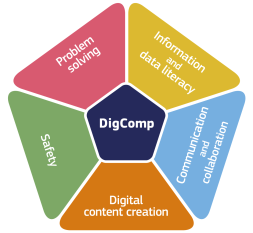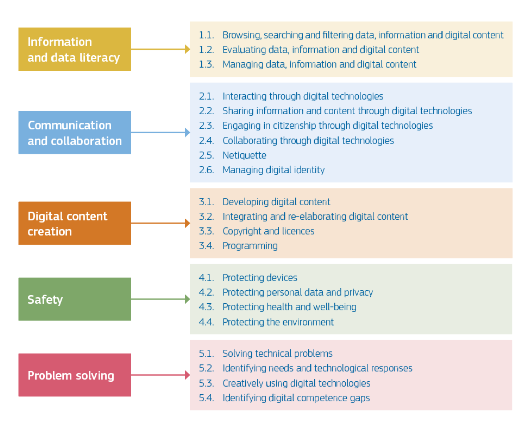The Digital Competence Framework for Citizens (DigComp) provides a common understanding to identify and describe the key areas of digital competence.
This EU-wide tool aims to help policy-makers formulate related initiatives, and plan education and training initiatives to improve proficiency of specific target groups while improving citizens’ digital competence.
DigComp 2.2, the latest version released, includes an update of the examples of knowledge, skills, and attitudes in comparison to its predecessor. It responds to increased digital literacy requirements as a consequence of emerging technologies.
Definition of Digital Competence
In DigComp, digital competence involves the 'confident, critical and responsible use of, and engagement with, digital technologies for learning, at work, and for participation in society. It is defined as a combination of knowledge, skills and attitudes'. (Council Recommendation on Key Competences for Life- long Learning, 2018).
Competence areas

The DigComp framework identifies the key components of digital competence in 5 areas (Dimension 1):
- Information and data literacy: To articulate information needs, to locate and retrieve digital data, information and content. To judge the relevance of the source and its content. To store, manage, and organise digital data, information and content.
- Communication and collaboration: To interact, communicate and collaborate through digital technologies while being aware of cultural and generational diversity. To participate in society through public and private digital services and participatory citizenship. To manage one’s digital presence, identity and reputation.
- Digital content creation: To create and edit digital content. To improve and integrate information and content into an existing body of knowledge while understanding how copyright and licences are to be applied. To know how to give understandable instructions for a computer system.
- Safety: To protect devices, content, personal data and privacy in digital environments. To protect physical and psychological health, and to be aware of digital technologies for social well-being and social inclusion. To be aware of the environmental impact of digital technologies and their use.
- Problem solving: To identify needs and problems, and to resolve conceptual problems and problem situations in digital environments. To use digital tools to innovate processes and products. To keep up-to-date with the digital evolution.
The DigComp Conceptual reference model

There are 21 competences that are pertinent to these areas, their titles and descriptors are outlined in Dimension 2. Taken together, Dimension 1 and 2 form the conceptual reference model.
Additional Dimensions outline Proficiency levels (Dimension 3), Examples of knowledge, skills and attitudes (Dimension 4) and Use cases (Dimension 5). The latest publication, DigComp 2.2, presents the consolidated framework.
1. Information and data literacy
| Competences (Dimension 2) |
|---|
| 1.1 Browsing, searching and filtering data, information and digital content To articulate information needs , to search for data, information and content in digital environments, to access them and to navigate between them. To create and update personal search strategies. |
| 1.2 Evaluating data, information and digital content To analyse, compare and critically evaluate the credibility and reliability of sources of data, information and digital content. To analyse, interpret and critically evaluate the data, information and digital content. |
| 1.3 Managing data, information and digital content To organise, store and retrieve data, information and content in digital environments. To organise and process them in a structured environment. |
2. Communication and collaboration
| Competences (Dimension 2) |
|---|
| 2.1 Interacting through digital technologies To interact through a variety of digital technologies and to understand appropriate digital communication means for a given context. |
| 2.2 Sharing through digital technologies To share data, information and digital content with others through appropriate digital technologies. To act as an intermediary, to know about referencing and attribution practices. |
| 2.3 Engaging in citizenship through digital technologies To participate in society through the use of public and private digital services. To seek opportunities for self-empowerment and for participatory citizenship through appropriate digital technologies. |
| 2.4 Collaborating through digital technologies To use digital tools and technologies for collaborative processes, and for co-construction and co-creation of resources and knowledge. |
| 2.5 Netiquette To be aware of behavioural norms and know-how while using digital technologies and interacting in digital environments. To adapt communication strategies to the specific audience and to be aware of cultural and generational diversity in digital environments. |
| 2.6 Managing digital identity To create and manage one or multiple digital identities, to be able to protect one's own reputation, to deal with the data that one produces through several digital tools, environments and services. |
3. Digital content creation
| Competences (Dimension 2) |
|---|
| 3.1 Developing digital content To create and edit digital content in different formats, to express oneself through digital means. |
| 3.2 Integrating and re-elaborating digital content To modify, refine, improve and integrate information and content into an existing body of knowledge to create new, original and relevant content and knowledge. |
| 3.3 Copyright and licences To understand how copyright and licences apply to data, information and digital content. |
| 3.4 Programming To plan and develop a sequence of understandable instructions for a computing system to solve a given problem or perform a specific task. |
4. Safety
| Competences (Dimension 2) |
|---|
| 4.1 Protecting devices To protect devices and digital content, and to understand risks and threats in digital environments. To know about safety and security measures and to have due regard to reliability and privacy. |
| 4.2 Protecting personal data and privacy To protect personal data and privacy in digital environments. To understand how to use and share personally identifiable information while being able to protect oneself and others from damages. To understand that digital services use a “Privacy policy” to inform how personal data is used. |
| 4.3 Protecting health and well-being To be able to avoid health-risks and threats to physical and psychological well-being while using digital technologies. To be able to protect oneself and others from possible dangers in digital environments (e.g. cyber bullying). To be aware of digital technologies for social well-being and social inclusion. |
| 4.4 Protecting the environment To be aware of the environmental impact of digital technologies and their use. |
5. Problem solving
| Competences (Dimension 2) |
|---|
| 5.1 Solving technical problems To identify technical problems when operating devices and using digital environments, and to solve them (from trouble-shooting to solving more complex problems). |
| 5.2 Identifying needs and technological responses To assess needs and to identify, evaluate, select and use digital tools and possible technological responses to solve them. To adjust and customise digital environments to personal needs (e.g. accessibility). |
| 5.3 Creatively using digital technologies To use digital tools and technologies to create knowledge and to innovate processes and products. To engage individually and collectively in cognitive processing to understand and resolve conceptual problems and problem situations in digital environments. |
| 5.4 Identifying digital competence gaps To understand where one’s own digital competence needs to be improved or updated. To be able to support others with their digital competence development. To seek opportunities for self-development and to keep up-to-date with the digital evolution. |
Publications
- DigComp 2.2: The Digital Competence Framework for Citizens - With new examples of knowledge, skills and attitudes (2022)
- DigComp 2.1: The Digital Competence Framework for Citizens with eight proficiency levels and examples of use (2017)
- DigComp 2.0: The Digital Competence Framework for Citizens. Update Phase 1: the Conceptual Reference Model (2016)
- DigComp: A Framework for Developing and Understanding Digital Competence in Europe (2013)
- Report on Online consultation Experts' views digital competence (2012)
- Digital Competence in Practice: An Analysis of Frameworks (2012)


